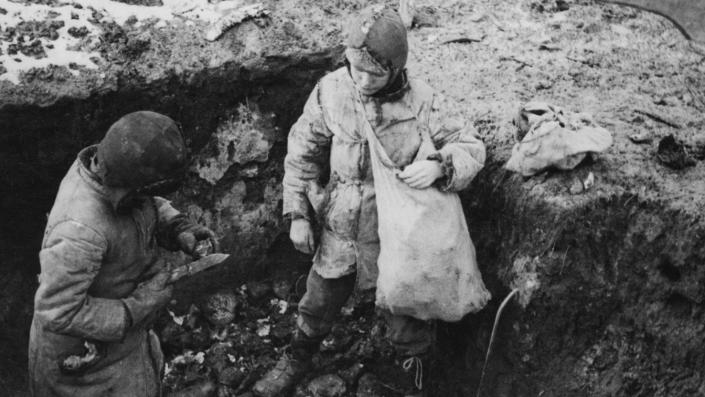WASHINGTON — In 2015, Ukrainian and American officials in Washington, D.C., unveiled a memorial to the Holodomor, the intentional starvation of some 4 million Ukrainians by the Soviet dictator Joseph Stalin in 1932-33.
As it had for decades, the Kremlin refused to take responsibility for the famine. Instead, Russia responded with an article published in its English-language propaganda outlet, Sputnik, deeming the Holodomor — which is widely considered to have been an act of genocide — a “hoax” exaggerated and propagated by “Ukrainian nationalists.”
With the invasion of Ukraine launched last month by Russian President Vladimir Putin, who has expressed his admiration of Stalin, memories of the Holodomor have come into sharp relief for Ukrainians, especially given reports that the humanitarian crisis is worsening.
“The Russian military have shifted their strategy to intentionally targeting Ukrainian civilians,” Olga Lautman, senior fellow at the Center for European Policy Analysis and a host of the “Kremlin Files” podcast, told Yahoo News. “Russian forces are also kidnapping volunteers who are trying to get food and water to civilians trapped.”
In its latest brief on the war, the World Food Program said that “Ukrainians continue to endure one of the fastest growing humanitarian crises of modern times,” adding that as “the crisis continues with no end in sight, basic necessities have become sparse and the delivery of humanitarian relief across borders is challenged by the ongoing conflict throughout the country.”
Kristina Hook of Kennesaw State University, an expert on Ukraine, says she has seen “a pattern of deliberate behavior by the Russian military to use violence to control the civilian population” of Ukraine, in an effort to pressure Kyiv to surrender on terms favorable to the Kremlin. Hook recently wrote in an Atlantic Council brief that “the war offers alarming echoes of past Russian aggression towards Ukraine.”
Ukraine has been a constant target of foreign aggression, but nothing is more deeply seared in the Ukrainian memory than the forced famine. Its name combines the Ukrainian words for “hunger” and “death”; in 2006, the nation’s democratically elected government deemed the Holodomor a genocide, meaning that outright extermination had been a primary motive.
Two years later, a memorial and museum were officially opened on a hilltop overlooking Kyiv.
“This is a unique tragedy that has no equal in human history,” Valentyna Borisenko, who works on oral histories of the Holodomor, told the Canadian Broadcasting Corporation in 2009. “Without the Holodomor, we would be a different people. The whole of our traditional culture and morals were destroyed.”
Russia has always maintained that the famine was a natural disaster. That argument was most famously endorsed by the New York Times correspondent Walter Duranty, an unabashed apologist for Stalin in his reporting from Ukraine at the time. In 1990, the Times branded his dispatches as “some of the worst reporting to appear in this newspaper,” but the newspaper has never explicitly renounced the Pulitzer Prize he won in 1934.
Today there is no disagreement about the role that the Kremlin played in the suffering inflicted on Ukraine.
“The Ukrainian famine was a clear case of a man-made famine,” says Alex de Waal, an expert on humanitarian crises who teaches at Tufts and heads the World Peace Foundation. He described the famine as “aimed at a particular population for repression or punishment.”
Stalin’s plan to “collectivize” — that is, consolidate in the name of socialism — farms across the Soviet Union in the late 1920s had gone extremely poorly. Ukraine’s arable land was famously fertile — its black soil is renowned for its high content of decomposed plant matter, as well as such minerals as phosphorus and ammonia — but the Soviets’ efforts there were especially ruthless, in part because the Kremlin viewed Ukraine as a colonial entity that could be manipulated at will.
Farmers who refused to give up their land were derided as kulaks (that is, “closed fists” not open to helping their comrades), harassed and stripped of land. As many as 30,000 kulaks were simply murdered by the Soviet secret police. “We will make soap of kulaks,” one Soviet slogan boasted during the brutal dekulakization effort. Hundreds of thousands were deported to the outer reaches of the Soviet empire.
Rebellions erupted across Ukraine, which only made the already paranoid Stalin even more so. Although he was not Russian, Stalin profoundly feared any hints of independence from the Soviet republics, each with its distinct national identity. Those yearnings have always been especially fierce in Ukraine and Stalin’s native Georgia, which Putin invaded in 2008.
When Putin invaded Ukraine for the first time in 2014, he was effectively making the same argument that Stalin had 90 years before. In an article on the “historical unity” between the two nations published last year, Putin wrote that Ukrainian independence was a historical fluke that had to be corrected.
Ukrainians wonder today why such purported kinship would necessitate a war in which hundreds of civilians have already died. The Holodomor is an even more painful reminder that the Kremlin’s assertions about Russians’ spiritual identification with Ukraine are simply a lie to disguise geopolitical designs.
Not only was the collectivization brutal, it was also inept. For all his invocations of the glories of Marxism-Leninism, as the prevailing Soviet ideology had come to be known, Stalin saw Ukraine and its people as resources to be exploited at will. “It was the intentional actions of the central government in establishing total control over the republic’s grain market that led most directly to the deprivation of economic entitlement in Soviet Ukraine,” the Ukrainian historian Liudmyla Hrynevych wrote last year.
Inescapable evidence of Ukrainians’ suffering was not met with compassion. A notorious Soviet decree known as “Five Stalks of Grain,” issued in 1932, designated taking food from a farm as theft of “socialist property.” Two thousand Ukrainians would be executed for the offense.
At the height of the famine, 28,000 people were dying daily, even as food and grain continued to flow to Russia. “Parents take whatever they find to their children, but they die themselves,” a Holodomor survivor, Pelaheia Tovkach, who was 5 at the time, would remember much later.
Some were so desperate that they turned to cannibalism. “I have eaten my children — and if you talk too much, I will eat you,” one villager from the Kyiv area replied, after someone observed that he appeared to be better off than others around him.
People fell dead on town streets. The bellies of children swelled with hunger.
Villages that couldn’t meet their quotas were “blacklisted” and singled out by violent paramilitary squads out to impose the harsh edicts of the Kremlin. Ailing peasant farmers suddenly found themselves subject to an incomprehensible ideological assault.
The squads “entered the villages and made the most thorough searches of the houses and barns of every peasant,” the historian Clarence Manning would write. “They dug up the earth and broke into the walls of buildings and stoves in which the peasants tried to hide their last handfuls of food.”
Taken in the aggregate, Stalin’s effort to collectivize Ukraine and then starve its people corresponded with the legal definition of genocide. Stalin “killed systematically rather than episodically,” the Stanford historian Norman Naimark has observed.
Survivors would never forgive the wanton destruction of human life they suffered at Russia’s hands. In Russia’s invasion of Ukraine today, they see the same callousness. “They say that they are our brothers. No, they aren’t,” the now 93-year-old Tovkach said last year, just before Russian troops began to amass on the Ukrainian border to resume the invasion Putin had begun eight years before.
Less than a decade after the Holdomor ended, World War II began. Some of the most brutal fighting would take place in Ukraine, which Hitler recognized as central to his geopolitical designs — just as Stalin had. “I need Ukraine so no one can starve us out again, as they did in the last war,” Hitler said. Millions of Ukrainians gave their lives in repelling the Germans.
Nor does blood alone soak through Ukraine’s black soil. A swath of northern Ukraine was contaminated with dangerous radionuclides when the Chernobyl nuclear power plant partially melted down in 1986.
The country has four nuclear plants, arguably one beneficial legacy of the Soviet Union — unless another nuclear disaster occurs. Some worry that the Russian carelessness that caused the Chernobyl disaster could lead to another potential meltdown, visiting yet more catastrophe upon a nation that has endured several in the past century. (Russia has already bombed the perimeter of one Ukrainian nuclear power plant.)
Ukrainian President Volodymyr Zelensky — members of whose own family perished in the Holocaust, which decimated the Jewish population of Ukraine — has evoked the memory of the Holodomor to rouse feelings of Ukrainian resilience. “Having lost millions of lives, Ukraine in the last century proved that we are a nation that cannot be conquered even by total famine,” he said at last year’s annual commemoration ceremony, which takes place in late November.
Such commemorations are themselves a relatively recent addition to Ukrainian public life. Even after Stalin died in 1953, the Soviet Union took no responsibility for the Holodomor, although Ukraine began to invoke the Stalinist atrocities in the 1980s.
The Soviet successor state, Russia, would continue along the same path, especially once Putin began rehabilitating Stalin’s image. Seventeen nations, alongside Ukraine, now officially recognize the Holodomor as a genocide.
Russia is not among them. Even as Putin is branded a “war criminal” by President Biden, he insists that it is Russian people who have been victimized by Ukrainian leadership, which he has falsely described as rife with “Nazis.”
Meanwhile, some Ukrainians are going hungry again under the onslaught of Russian shelling and bombing. One blogger had a disconcertingly pithy take on the destruction that the Kremlin is inflicting on Ukrainians once again: “Putin’s Holodomor.”




